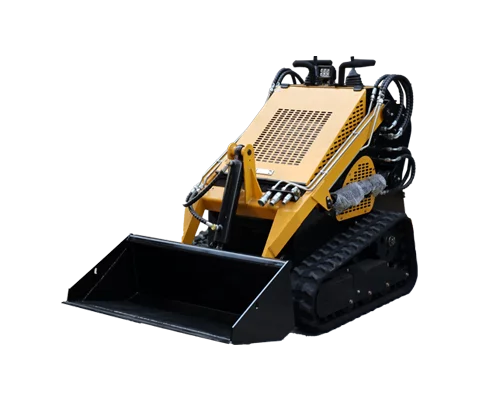Bienvenue sur mon blog !
Avant de plonger dans le contenu, j'aimerais que vous me rejoigniez sur mes plateformes de médias sociaux où je partage plus d'informations, je m'engage avec la communauté et je publie des mises à jour. Voici comment vous pouvez vous connecter avec moi :
Facebook:https://www.facebook.com/profile.php?id=100087112105480
LinkedIn:https://www.linkedin.com/showcase/99327366/admin/dashboard/
Maintenant, commençons notre voyage ensemble. J'espère que vous trouverez le contenu de ce site perspicace, intéressant et utile.
Introduction

Dans les environnements en constante évolution de la construction et de l'agriculture, l'efficacité des machines peut faire le succès ou l'échec d'un projet. La chargeuse compacte est l'une des machines les plus polyvalentes utilisées aujourd'hui. Bien que de nombreux facteurs contribuent aux performances globales de ces machines, il est essentiel de comprendre les dimensions des chargeuses compactes pour maximiser l'efficacité du travail. Ce blog explore la façon dont les différentes dimensions des chargeuses compactes affectent leur fonctionnement, leur maniabilité, leur stabilité et leur efficacité globale sur les chantiers.
Comprendre Dimensions des chargeurs compacts
Les chargeuses compactes sont disponibles en différentes tailles, chacune étant conçue pour des tâches et des environnements spécifiques. Les dimensions clés qui influencent leurs performances sont les suivantes :
- Longueur totale: La longueur totale de la machine, qui peut dicter la maniabilité.
- Largeur totale: Important pour la stabilité et l'accès dans les espaces étroits.
- Hauteur totale: Influence la visibilité et la portée lors des tâches de levage.
- Empattement: Affecte la répartition du poids et la stabilité générale.
- Capacité de fonctionnement: Le poids maximum que le chargeur peut soulever en toute sécurité.
Ces dimensions de chargeuses compactes jouent un rôle essentiel dans la détermination de l'efficacité de la machine dans différents scénarios.
Impact des dimensions sur l'efficacité de l'emploi
Maniabilité et accessibilité
Les dimensions d'une chargeuse compacte influencent considérablement sa maniabilité sur les chantiers. Les modèles plus petits, caractérisés par des longueurs et des largeurs réduites, sont idéaux pour naviguer dans les espaces restreints. Par exemple, une chargeuse aux dimensions compactes peut facilement fonctionner sur des chantiers urbains ou dans des espaces paysagers étroits. Cette capacité à manœuvrer efficacement augmente l'efficacité globale du travail, permettant aux opérateurs d'accomplir leurs tâches rapidement et en toute sécurité.
Dimensions et maniabilité
| Dimension | Impact sur la manœuvrabilité |
|---|---|
| Longueur totale | La longueur réduite améliore l'accès aux espaces confinés |
| Largeur totale | La largeur réduite facilite la navigation dans les passages étroits. |
| Empattement | L'empattement plus court augmente l'agilité dans les virages serrés. |
Stabilité et manutention des charges
La stabilité est essentielle lors de l'utilisation d'une chargeuse compacte, en particulier lors du levage et du transport de charges lourdes. Les chargeuses à empattement plus long offrent généralement une meilleure stabilité, ce qui est essentiel pour manipuler des matériaux lourds en toute sécurité. Toutefois, si les empattements plus longs améliorent la stabilité, ils peuvent réduire la maniabilité. Les opérateurs doivent tenir compte des dimensions de la chargeuse compacte pour trouver un équilibre qui corresponde à leurs besoins opérationnels spécifiques.
Compatibilité de l'attachement
Les dimensions d'une chargeuse compacte ont une incidence directe sur la gamme d'accessoires pouvant être utilisés efficacement. Les chargeuses plus grandes peuvent souvent recevoir des accessoires plus lourds et plus robustes, tels que des grappins hydrauliques ou des godets de grande capacité. À l'inverse, les chargeuses plus petites sont généralement conçues pour des outils plus légers et spécialisés. Comprendre la relation entre les dimensions des chargeuses compactes et la compatibilité des accessoires aide les opérateurs à choisir l'équipement adéquat, ce qui améliore l'efficacité du travail.
Portée et visibilité
La hauteur totale d'une chargeuse compacte joue un rôle important dans la portée et la visibilité. Les chargeuses plus hautes peuvent atteindre des hauteurs de déversement plus importantes, ce qui est particulièrement utile pour charger des camions ou empiler des matériaux. En outre, la hauteur accrue améliore la visibilité de l'opérateur, réduisant les angles morts et renforçant la sécurité sur les chantiers. Il est donc essentiel de tenir compte de la hauteur dans les dimensions des chargeuses compactes pour assurer un fonctionnement efficace.
Pression du sol et compatibilité de la surface
Les dimensions de la chargeuse compacte influencent également la pression au sol, un facteur important lorsque l'on travaille sur des surfaces molles ou irrégulières. Une machine plus large répartit généralement le poids sur une plus grande surface, ce qui réduit la pression au sol et minimise le risque d'enfoncement dans un sol mou. Cette caractéristique est particulièrement importante pour les projets d'aménagement paysager et de construction impliquant un sol mou ou instable. Comprendre comment les dimensions d'une chargeuse compacte affectent la pression au sol peut permettre de mieux choisir l'équipement et d'améliorer l'efficacité du travail.
Transport et stockage
La taille d'une chargeuse compacte influe sur ses capacités de transport et de stockage. Les petites chargeuses peuvent être facilement transportées sur des remorques standard et nécessitent moins d'espace de stockage, ce qui les rend idéales pour les entrepreneurs qui déplacent fréquemment leur matériel. Les chargeuses plus grandes, en revanche, peuvent nécessiter des solutions de transport et de stockage spécialisées, ce qui peut avoir un impact sur l'efficacité opérationnelle globale. Le choix des dimensions de la chargeuse compacte en fonction de vos besoins peut simplifier la logistique du transport et du stockage.
Confort et accessibilité de l'opérateur
Le confort de l'opérateur est directement lié à l'efficacité du travail. Les dimensions de la cabine, y compris la hauteur et la largeur, ont une incidence sur le confort de travail de l'opérateur. Une cabine spacieuse permet une meilleure ergonomie et réduit la fatigue pendant les longues heures de travail. S'assurer que les dimensions de la chargeuse compacte tiennent compte du confort de l'opérateur peut conduire à des niveaux de productivité plus élevés sur le lieu de travail.
Avantages des différentes dimensions de chargeurs

| Dimension | Bénéfice |
|---|---|
| Longueur totale courte | Manœuvrabilité améliorée dans les espaces restreints |
| Largeur étroite | Amélioration de la navigation dans les couloirs étroits |
| Empattement long | Stabilité accrue lors de la manipulation de charges lourdes |
| Plus grande taille | Plus grande portée pour les tâches de levage et de déversement |
| Cadre plus large | Pression au sol réduite pour les opérations sur des surfaces molles |
Conclusion
Une compréhension globale de dimensions de la chargeuse compacte est essentielle pour maximiser l'efficacité du travail dans diverses applications. Qu'il s'agisse d'améliorer la maniabilité et la stabilité ou d'influer sur la compatibilité des accessoires et le confort de l'opérateur, ces dimensions jouent un rôle essentiel dans la détermination de l'efficacité avec laquelle une chargeuse peut accomplir ses tâches. En prenant soigneusement en compte les dimensions de la chargeuse compacte lors de la sélection de l'équipement, les opérateurs peuvent améliorer leur productivité et obtenir de meilleurs résultats pour leurs projets.
FAQ
Quelles sont les dimensions typiques d'un chargeuse compacte?
Les dimensions des chargeuses compactes peuvent varier considérablement, mais les modèles typiques ont une longueur totale de 10 à 12 pieds, une largeur de 4 à 6 pieds et une hauteur de 6 à 8 pieds.
Quelle est l'influence de la longueur totale sur les performances ?
La longueur totale a une incidence sur la maniabilité ; les chargeurs plus courts conviennent mieux aux espaces restreints, tandis que les chargeurs plus longs peuvent offrir une meilleure stabilité lors du levage de charges lourdes.
Quelle est l'importance de l'empattement dans chargeuses compactes?
L'empattement influe sur la stabilité et l'agilité. Un empattement plus long offre généralement une plus grande stabilité, en particulier lors de la manutention de charges lourdes, mais il peut limiter la maniabilité dans les espaces restreints.
Puis-je utiliser différents accessoires avec n'importe quelle chargeuse compacte ?
Tous les accessoires ne sont pas compatibles avec toutes les chargeuses compactes. Vérifiez toujours les spécifications de la chargeuse et les exigences de l'accessoire pour assurer la compatibilité en fonction des dimensions de la chargeuse compacte.
Quelle est l'influence de la hauteur sur une chargeuses compactes l'efficacité ?
La hauteur influe sur la portée et la visibilité. Les chargeurs plus hauts peuvent déverser à des hauteurs plus importantes et offrent une meilleure visibilité, ce qui améliore la sécurité et l'efficacité.
